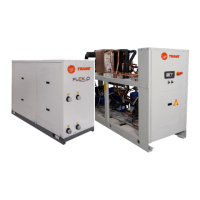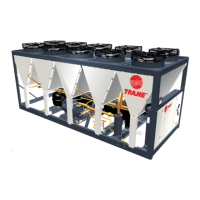Page 57
10 OPERATOR RESPONSIBILITIES
It is important that the operator is properly trained and familiar with the equipment before working on the unit. In addition
to reading this manual, the operator must study the manual operation of the microprocessor and the wiring diagram to
understand the sequence of start- up, operation, shutdown sequences, and the criterion of operation of all safety devices.
During the initial start-up of the unit an authorized technician is available to answer any questions and educate on the
proper functioning. We recommend the operator to maintain a record of the operating data for each unit installed and all
maintenance activities and periodic service. If the operator observes abnormal or unusual operating conditions, consult
the authorized service technician.
11 START-UP PRELIMINARY PROCEDURES
11.1
STARTING CHECK
Before starting the unit, even only momentarily, all the equipment part of the chilled water/hot water loops, like the air
handling units, water pumps, strainers, valves etc. have to be checked. The pump auxiliary contacts and the flow switch
have to be connected to the control panel as indicated in the electrical diagram. Before carrying out interventions on the
valve regulations, loosen the relevant valve gland. Open the discharge valve of the compressor. Open the liquid shutoff
valve placed on the liquid line. Measure the suction pressure. If it is lower than 0.42 MPa pry open the solenoid valve on
the liquid line by means of an electrical bridge. Bring the suction pressure to 0.45 MPa, then remove the jumper. Charge
all the water circuit progressively. Starts up the water pump of the evaporator with the calibration valve shut and then
slowly open it.
Discharge the air from the high points of the water circuit and check the direction of the water flow. Carry out calibration
of the flow by using a measurer (if present or available) or by means of a combination of the readings of the manometers
and the thermometers. In the starting phase calibrate the valve on the pressure difference read on the manometers, carry
out drainage of the tubes and then carry out fine calibration on the temperature difference between the water in and the
water out. The regulation is calibrated in the factory for water in to the evaporator at 12°C and water out at 7°C. With the
general switch open, check that the electrical connections are tightly clamped. Check for any possible refrigerant leaks.
Check that the electrical data on the label correspond to those of the mains supply. Check that the thermal charge
available is appropriate for starting.
11.2
REFRIGERANT SEALS CONTROL
Trane units are factory charged with the complete charge of refrigerant and are at a sufficient pressure to check the seal
after installing. If the system were not under pressure, blow refrigerants (vapour) into it until pressure is reached and look
for leakage.
After having eliminated the leakage, the system has to be dehydrated with a vacuum pump up to at least 1mm Hg -
absolute pressure (1 Torr o 133.3 Pa). This is the minimum recommended value to dehydrate the plant.
Danger: Do not use the compressor to vacuum the system.
11.3
REFRIGERANT CHARGE CHECK
Trane units are supplied with a complete charge of refrigerant. If bubbles can be seen through the peephole with the
compressor running with a full charge and steadily, it means that the refrigerant charge is insufficient.

